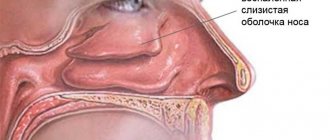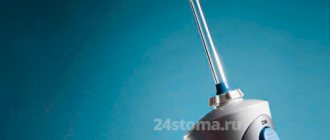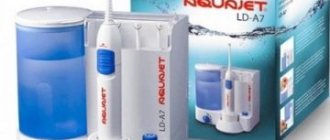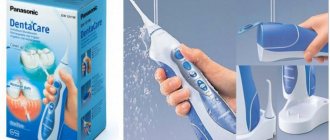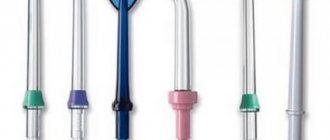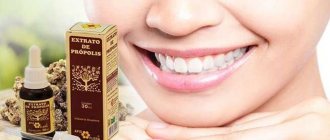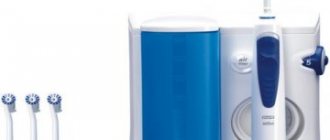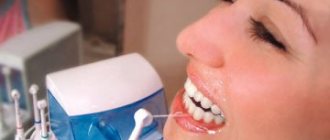The health and beauty of your teeth largely depends on how carefully your oral hygiene is maintained. Cleaning teeth from food debris and plaque with a toothbrush, due to the complexity of the dentition, the presence of hard-to-reach areas, and interdental spaces, is not effective enough. Dentists have long used irrigation in their professional practice to clean teeth. Now the home arsenal of dental care products has been replenished with a new device - an oral irrigator.
Why do you need an irrigator?
Irrigator is a derivative of the Latin word irrigatum, which means “to irrigate.” This is a device that allows you to use water to clean your teeth from organic residues remaining in the mouth after eating. The irrigator does not replace the action of a toothbrush. An irrigator is especially necessary when wearing orthopedic devices (bridges, brackets, brackets and others). With its help, structural elements and the surface of the teeth that come into contact with them are cleaned.
Types of equipment for cleaning technology
If we classify devices according to sedum technology, they are:
- With a pulsating jet. Allows you to get a very thin stream with a short pulsation. During their operation, a microhydraulic shock mode is created, thanks to which soft plaque is quickly removed. Pulsation is ideal for people prone to periodontitis and gingivitis.
- Microbubbles. Considered the most effective. During operation, air and liquid are mixed. Oxygenated water cleans crowns better. The microbubble system is optimal if the patient often has inflamed gums, has crowns, or implants. It can even be used to rinse the nasal passages and oropharynx, which is important for people suffering from chronic rhinitis and pharyngitis.
- With mono jet. They are arranged quite simply. Essentially, these are adapters between a water tap and a person’s mouth. The products do not allow the use of antibacterial medicinal compounds or filtered water, as they are connected directly to the tap. But some of them are equipped with a capsule into which you can additionally add antibacterial liquid. Monojet techniques are suitable for the prevention of various dental diseases. Its main advantage is its affordable price. But in terms of the effectiveness of enamel cleansing, it is significantly inferior to the first two options.
Operating principle of the irrigator
The principle of operation of the irrigator is based on the flow of a very thin stream of water under high pressure onto the elements of the oral cavity to be cleaned. This method of treating the oral cavity not only washes out the smallest food debris and removes plaque from the teeth, but also massages the gums, which improves blood circulation. The device consists of a hydraulic pump, a container for liquid and a handle with replaceable nozzles.
The reservoir is filled with water or solution, under the action of the compressor the pressure rises, and the liquid rushes to the handle with the nozzle. Different irrigator models provide a variety of water jet supply modes, which can be pulsating, spraying, constant, centered, or spraying. The liquid used is plain water or solutions with added agents that enhance the therapeutic and preventive effect of the procedure. Solutions of fluoridated, calcined liquid, antiseptics, antibacterial drugs, herbal infusions, and compositions for strengthening gums are used. Special attachments on the handle ensure that the water jet reaches areas of the dentition that are inaccessible to a toothbrush and floss.
Content:
- What is this?
- How Irrigation Systems Work - A Brief Overview
- Who should buy
- What to look for when choosing
- Types of equipment for cleaning technology
- Which irrigator is better - choosing the right device for teeth
- How to use it correctly
- When not to use
To ensure the best possible care for your teeth and gums, it is not enough to use only toothpaste, brush and floss. It is also advisable to arm yourself with an oral irrigator. By choosing the best device for yourself, a person will be able to avoid many dental diseases and problems.
Benefits of an irrigator
The benefit of the irrigator is better cleaning of the oral mucosa, surface of the teeth, interdental spaces, as well as orthopedic structures. And the absence of a biological substrate for the proliferation of bacteria and the rotting of food debris is the prevention of the development of dental diseases. Medical studies have found that a three-second treatment with pulsating water using an oral irrigator removes up to 99.9% of bioplaque on teeth.
Oral irrigator features:
- Significantly reduces the risk of developing caries.
- Promotes rapid healing of gums through micromassage.
- Disinfects and refreshes the oral cavity with antiseptic solutions.
- Cleans gum pockets and prevents the development of periodontal disease.
- Treats the oral mucosa with medicinal solutions for stomatitis
- Prevents the deposition of pigment on the surface of tooth enamel when smoking, drinking strong coffee, tea, red wine.
- Removes plaque from the mucous membrane of the tongue and gums, which reduces bacterial contamination of the oral cavity.
- Prevents destruction of the enamel coating of teeth when installing braces, braces and other orthopedic devices.
- To reduce trauma to soft tissues due to bleeding and loosening of the gums, replace the toothbrush.
Seven signs to look out for
Do you want to check how your toothbrush copes with its function and whether the Waterpik irrigator has advantages? You can assess the condition of your teeth using these signs:
- presence of caries,
- the presence of tartar (hard plaque that hardens on the teeth as a result of insufficient daily brushing),
- presence of bacteria on teeth,
- presence of gum disease (bleeding and others),
- Are your teeth hypersensitive (do they react to things that are too cold or too hot with aching pain),
- “yellowishness” of teeth or the presence of so-called dark plaque,
- freshness of breath, which is also reflected by the presence of food debris between the teeth.
The detection of several of the seven signs directly indicates that the quality of oral hygiene is insufficient. Clinical studies prove that long-term use of the Waterpik irrigator significantly reduces the risk of identifying seven so-called signs of unhealthy teeth.
Types of irrigators
Types of irrigators differ from each other in technical characteristics, design, and operating principles. Stationary models are placed in the bathroom and operate from the mains. They are equipped with a large capacity for liquid and have a powerful engine that creates a high level of pressure. The device is usually used by the whole family, so it comes with many attachments.
How to use it correctly
The devices are very easy to use. Before you turn them on, you need to brush your teeth the old fashioned way - with a brush and toothpaste. Only after this proceed to treating the interdental spaces with water flow. The reservoir can be filled with dental solution prescribed by your doctor.
The tip must be held in such a way that the jet is delivered at an angle of 60 to 90 degrees. The duration of the cleansing procedure should be up to ten minutes. Children under six years of age may only use the equipment under parental supervision. It is forbidden to mess with him.
Flaws:
- The energy source is too small to create the required water jet pressure.
- The need to frequently replace batteries or charge the battery.
- The volume of water is not enough to fully clean the oral cavity.
- Flow irrigators are attached to a water tap and use the pressure of the water supply system. Special tap valves allow you to regulate the fluid pressure.
- Mechanical types of irrigators are now rarely used. These are devices in which the pressure required to produce a jet is achieved by mechanical action on the piston. There is a key on the body of the device that is pressed to increase the pressure in the vessel with the liquid. The efficiency of such a device is low
- Tap water mixed with chlorine and heavy metal salts enters the oral cavity.
- There is no pulsation mode.
- Often the water pressure is not enough for effective cleaning.
- Modern models use the latest fine-bubble cleaning method, which is considered the most effective.
- The pulsation mode also promotes the rapid removal of microparticles of organic substances from teeth and orthopedic structures.
How Irrigation Systems Work - A Brief Overview
To make it easier for a person to understand which irrigator to buy, it is necessary to first understand the operating principles of different models. The jet in various devices can be:
- continuous;
- pulsating;
- including microscopic bubbles.
It is permissible to fill the system with ordinary running water or a special dental solution. A large selection of tips and the option of supplying jets of different power allow you to fully rinse hard-to-reach areas that cannot be reached with a conventional brush.
Types of removable attachments
Several types of attachments have been developed to perform various oral hygiene tasks:
- The standard one is used for daily brushing of teeth.
- Periodontal is designed to cleanse gum pockets.
- Nozzle for removing plaque from the tongue.
- The orthodontic attachment is used to care for braces and other dental devices.
- The brush attachment performs the work of a classic toothbrush and massages the gums.
- The teeth whitening attachment is used in the process of cleaning and polishing the enamel.
- Manufacturers of irrigators and their features
- In the modern market of dental devices, irrigators are presented in a wide range.
Irrigator - a device for cleaning teeth and gums
First, let's figure out what this personal hygiene item is. The irrigator resembles an electric toothbrush with a thin tip instead of bristles. This device operates on the principle of a hydraulic compressor. Pressure is created inside the device, pushing water through the tip under high pressure. The flow of liquid washes away plaque and food particles from the teeth, cheeks, gums and tongue, thereby preventing the development of numerous dental diseases. Some experts do not recommend using the device for patients with problem gums, fearing that it may worsen the situation. However, modern devices, as a rule, have a built-in massage mode that strengthens soft tissues and improves their condition. However, people with acute inflammation should not use the device for some time.
The unique, multifunctional device JETPIK JP200 Elite combines an electric sonic toothbrush, irrigator and dental floss. The components and the device itself are stored in a convenient plastic container, which is ideal for traveling or storing in a small bathroom.
Dentist advice
Before you start using the device, you need to consult a dentist who will help you choose the optimal fluid supply mode, frequency of use, and solution composition. Compliance with all operating rules is the key to safe use of the irrigator. Rules for using the irrigator:
- Cleaning should begin with a gentle regime, gradually increasing power over 7-10 days.
- It is not recommended to use the device earlier than 24 hours after installing any orthodontic structures in the oral cavity.
- The liquid stream should be directed towards the teeth at a right angle.
- It is permissible to use an irrigator for children from 6-7 years of age, always under adult supervision. A high-pressure jet of water entering a child's windpipe can cause tracheal spasm and asphyxia.
- Long-term use of aseptic solutions can disrupt the normal microflora of the oral cavity and cause dysbacteriosis.
- The device can be used for gingivitis and periodontitis only during remission.
- The duration of the procedure is 5-10 minutes.
Who should buy
In addition to users of braces and other orthodontic systems, people who:
- want to keep their smile healthy;
- prone to the formation of large amounts of stone;
- fight the problem of unpleasant odor;
- suffer from increased bleeding gums;
- have crooked teeth, due to which certain areas cannot be properly cleaned.
When deciding which mechanism is best, it is important to understand that it only serves as an additional means of cleansing the mouth. It is impossible to replace a brush or, for example, floss with a device of this type.
Dentists recommend using the system three times a week and only if there is an urgent need. This is quite enough to ensure that the gums remain healthy, and “deposits” of food residues do not form in the interdental spaces.
Device, principle of operation and purpose
The name of the device translated from Latin means a device for irrigation.
Using a strong jet of water mixed with air bubbles, the irrigator removes soft plaque from the enamel, food debris stuck between the teeth, and massages the gums. The device does not replace brushing your teeth, but complements it. How does an irrigator work? This is an electrical device that runs on mains or batteries. Consists of the following parts:
- handles;
- water container;
- shower heads.
One of the most common irrigator form factors
The device is equipped with an electric motor and a compressor that creates the necessary fluid pressure. When turned on, water is mixed with air and forcefully thrown out through the shower head.
Which is better: an irrigator or dental floss - the result
Thus, it is impossible to say unequivocally what is better: an irrigator or dental floss and whether an irrigator can replace dental floss . Each of these hygiene products has its own advantages and disadvantages. The best option is a combination of thread and irrigator, depending on the situation. The irrigator does not require special manual dexterity and dexterity when using, however, as mentioned above, dental floss is a more budget-friendly and convenient option for constant use in any place where you stay.
Making your own irrigator from a syringe
An irrigator can be made from a syringe. To do this you will need the following tools:
- 5 ml or 20 ml syringe (volume depends on personal needs);
- sandpaper for grinding down the needle point;
- mouth rinse.
Tools for making a DIY irrigator
The device is quite easy to make yourself. To do this you will need to do the following:
- Take the needle from the syringe and carefully grind off the tip with sandpaper. You can use sharper tools, such as a knife, to remove the pointed part. Next, you need to sharpen the damaged surface so that when using a homemade device, family members do not damage the gums.
- Carefully bend the remaining part of the needle so that it resembles a standard nozzle in shape.
- If the needle cannot be bent, you can heat it a little over the fire and carefully bend it into the required shape.
- To use a home-made device, you need to assemble the syringe, remove the plunger and pour in the used teeth cleaning product.
- Then insert the piston into the syringe and, using gentle pressure, provide the necessary pressure for the jet. In this way, the interdental spaces are cleaned from food debris, protecting teeth from plaque.
Option for a homemade irrigator from a syringe
Some masters use a speed regulator from a simple medical dropper instead of a needle. To do this, cut off the required length of the nozzle and secure it with wire. The regulator can be used to adjust the fluid supply power. The homemade device is not recommended for use for cleaning the mouth of children.
Syringe with dropper regulators
Contraindications for use of the device
In addition to the enormous benefits, the presented device has contraindications:
- postoperative period of dental surgery;
- stage of exacerbation of gum disease;
- recovery period after installation of braces or implants;
- diseases of the cardiovascular system, which lead to bleeding gums due to damage to blood vessels;
- period of course treatment of dental diseases.
Cleaning the bracket system
It is not recommended to use the irrigator for children under 6 years of age, as well as for those people who have previously experienced prolonged bleeding of the gums.
